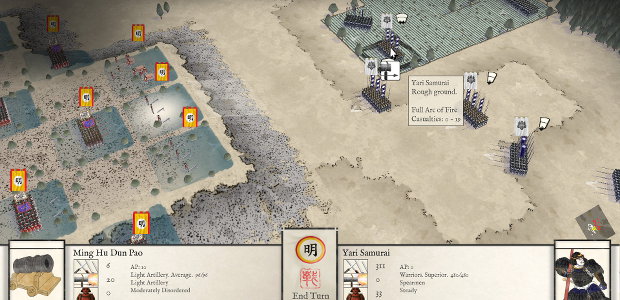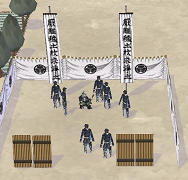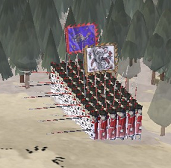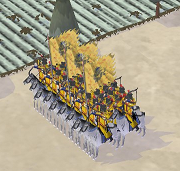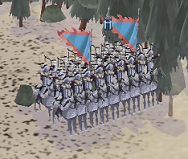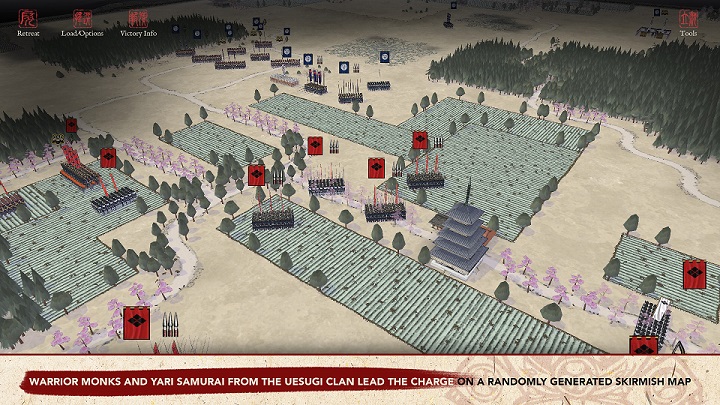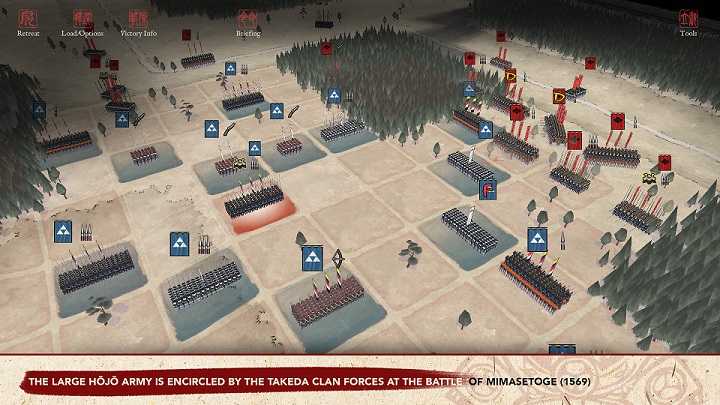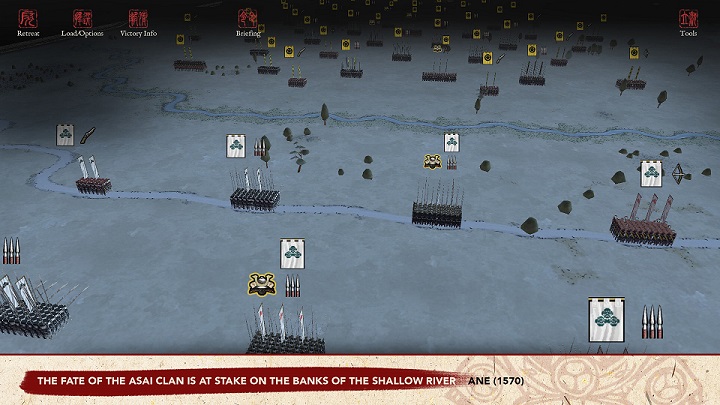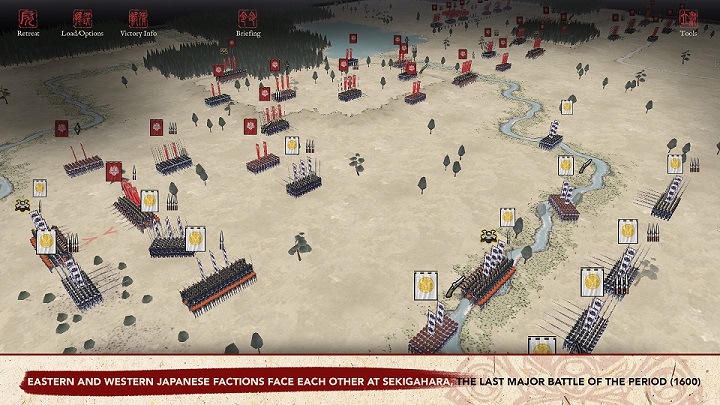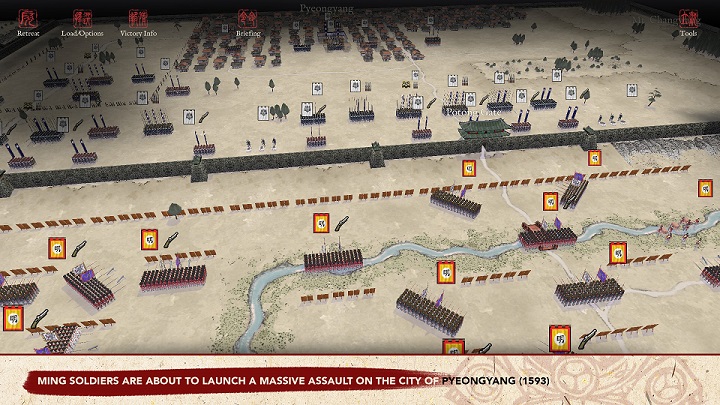
May 30, 2016
Sengoku Jidai: Shadow of the Shogun - Alberto
Pike & Shot and the recently released Sengoku Jidai have a quite unique system: players have, under certain conditions, limited control of their units. Entire regiments can be locked in close combat and the player won’t be able to order to disengage. This becomes even more evident when an enemy unit routs as the consequence of a charge and the player’s unit continues its charge independently from the player’s wishes. The author of Sengoku Jidai: Shadow of the Shogun and Pike & Shot Campaigns, Richard Bodley Scott, explains the reasons behind his decisions.
In the days when battles were decided by hand-to-hand combat it was largely impossible for a commander to successfully order a unit to disengage and go and do something else. In fact, in the rare cases where this was attempted, it often led to a mass panic as neighbouring units thought that the retreating unit was broken and themselves broke as a result.
Even the Romans, who reportedly had a system of line replacements (although nobody has yet figured out satisfactorily how this worked) only replaced one unit with the one immediately behind it (if indeed they did so). The replaced unit did not then go off and do something else.
Likewise it was normal for troops who routed their opponents in close combat to pursue the enemy at least for some distance before being brought back under control.
What led you to implement such a feature? Would you say you were inspired by any particular game or system?
I have been playing Ancient, Medieval and Renaissance tabletop minatures games since 1971. Loss of control of units in close combat is normal in such games, as is units pursuing routed enemy (except in some rather abstracted systems such as DBx). This is because those games are based as closely as possible on the history and this was normal behaviour for troops in the era before battles were decided almost entirely by shooting. Pike and Shot and Sengoku Jidai follow the tradition of tabletop miniatures games, without all the hassle of collecting and painting figurines.
Would you say that it adds to the realism of the game?
Certainly it does.
What notable examples from history are there of this occurring?
There are countless historical examples of pursuits getting out of hand and troops either not returning to the fray soon enough to influence the result of the battle, or themselves being routed in their turn by enemy reserves. To name a few: At the Battle of Magnesia in 190 BC, the victorious Seleucid right wing, under the command of King Antiochos in person, pursued the routed Roman left wing as far as the Roman camp, and failed to come back in time to save the rest of the Seleucid army, resulting in a decisive Seleucid defeat. During the Imjin War the Japanese used the Korean and Ming cavalry’s tendency to pursue in a disorganized fashion to lure them into a trap and destroy them at the Battles of the Imjin River and Byeokjegwan. In the English Civil War the Royalists lost several battles because their victorious cavalry pursued for several miles right off the battlefield and failed to return in time to influence the infantry fight. At the battle of Waterloo the Scots Greys completed their objective of routing the French 1st Corps, but then carried on without orders to Napoleon’s Grand battery, only to be counter charged by French cavalry and routed.
How does this feature affect the tactical depth of the game in your opinion? And how is the gameplay affected?
This feature increases the tactical depth of the game because it forces the player to act like a real general and allow for the fallibility of his own troops. It also increases the tension in the game play, because a local victory can soon turn into a reverse if troops pursue into danger. The player needs to take precautions to retrieve the situation if this occurs.
Are there times when the player can use it to their advantage?
Very definitely. A properly set up flank charge can roll up several units by routing one unit, pursuing into another, routing that and pursuing into another.
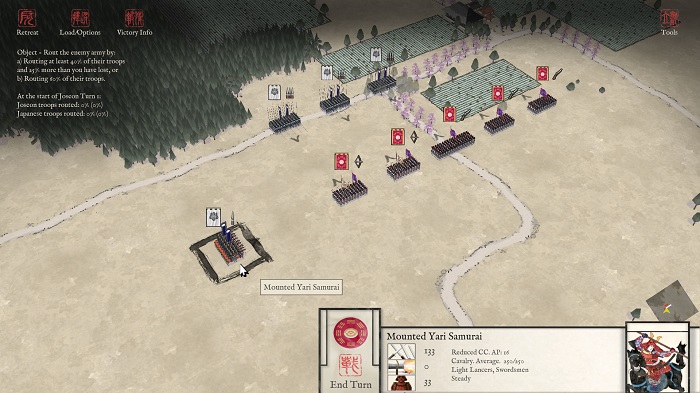
Example: The Samurai cavalry can charge the nearest Korean infantry unit in the flank. If they rout it, they will pursue into the next unit’s flank and so on. They may succeed in rolling up several units.
Are there ways a skilled player can mitigate the effects of this?
That too. In Sengoku Jidai, infantry who originally received a charge at the halt will seldom pursue enemy infantry and almost never pursue enemy cavalry.
Careful positioning prior to charging can result in units pursuing behind the enemy flank instead of off the table. This can then leave the pursuing unit in a good position to attack the rear of the enemy line in subsequent turns.
Charging disrupted enemy front line infantry with cavalry can lead to the cavalry routing their immediate enemy then pursuing into lower quality rear echelon units and routing them too.

Example: The samurai cavalry are not in a position to flank the Korean infantry, but if they charge the indicated unit and rout them, they will pursue behind the Korean line. The Koreans have no reserves, so once the cavalry come back under control they are likely to be in a position to charge the Korean infantry in the rear.
Why can’t your units always charge what you want?
The priority target system is there to enhance the realism of the game.
Firstly, it prevents units from charging one enemy unit while ignoring a more pressing threat from another unit. This helps to compensate for the IGOUGO system – in reality the other enemy units would not stand by idly while your unit attacked the unit of your choice. Because of this, no sane unit commander would order the attack against the non-priority target, and if he did, the troops might not obey. The player is supposed to represent the C-in-C, and although he gets to move all the units, he cannot override the tactical priorities of the unit commanders – in reality he would not have time to do so.
Secondly it prevents units facing a line or chequerboard of enemy units from ganging up on one unit while ignoring the enemy directly to their front. Allowing this would be very unrealistic.
Most infantry cannot charge cavalry. This is because their historical tactical doctrine would not allow them to do so. The normal behavior of infantry in the presence of enemy cavalry was to adopt a defensive posture to repel any attack. To avoid micromanagement, the game assumes this happens automatically, it does not require you to issue an “adopt defensive formation” order.
Even when the cavalry are already engaged in close combat, disciplined infantry would not normally charge them. This is because cavalry combats were not in reality the static affair that they appear to be on the map. In real life the cavalry would not be in one position long enough for the infantry to attack them, and if the infantry were foolish enough to break defensive formation to attack them they would be putting themselves at risk of a counterattack which they would not be able to repel because they would no longer be in the correct formation. Hence they would not risk it.
So you have little control of your units most of the time after the initial deployment?
This is not true at all.
In the early stages of the battle you have full control of all of your troops. As the battle develops and you commit units to hand-to-hand combat, you lose control of those units for a variable length of time while the combat continues, but you regain control of them once the combat and any pursuit that may occur is over.
This is part of the realism of the simulation and follows Motke’s famous dictum: “No plan survives contact with the enemy”.
However, you still have full control of all troops not in hand-to-hand combat or pursuing, and proper tactical use of those is what will usually decide the issue. In fact locking enemy units in hand-to-hand combat can keep them pinned long enough for you to set up and execute a flank attack on them.
It is a stark fact that skilled players will almost always beat less skilled players in Pike and Shot and Sengoku Jidai. This clearly demonstrates that they have enough control over their units to achieve this.
In the days when battles were decided by hand-to-hand combat it was largely impossible for a commander to successfully order a unit to disengage and go and do something else. In fact, in the rare cases where this was attempted, it often led to a mass panic as neighbouring units thought that the retreating unit was broken and themselves broke as a result.
Even the Romans, who reportedly had a system of line replacements (although nobody has yet figured out satisfactorily how this worked) only replaced one unit with the one immediately behind it (if indeed they did so). The replaced unit did not then go off and do something else.
Likewise it was normal for troops who routed their opponents in close combat to pursue the enemy at least for some distance before being brought back under control.
What led you to implement such a feature? Would you say you were inspired by any particular game or system?
I have been playing Ancient, Medieval and Renaissance tabletop minatures games since 1971. Loss of control of units in close combat is normal in such games, as is units pursuing routed enemy (except in some rather abstracted systems such as DBx). This is because those games are based as closely as possible on the history and this was normal behaviour for troops in the era before battles were decided almost entirely by shooting. Pike and Shot and Sengoku Jidai follow the tradition of tabletop miniatures games, without all the hassle of collecting and painting figurines.
Would you say that it adds to the realism of the game?
Certainly it does.
What notable examples from history are there of this occurring?
There are countless historical examples of pursuits getting out of hand and troops either not returning to the fray soon enough to influence the result of the battle, or themselves being routed in their turn by enemy reserves. To name a few: At the Battle of Magnesia in 190 BC, the victorious Seleucid right wing, under the command of King Antiochos in person, pursued the routed Roman left wing as far as the Roman camp, and failed to come back in time to save the rest of the Seleucid army, resulting in a decisive Seleucid defeat. During the Imjin War the Japanese used the Korean and Ming cavalry’s tendency to pursue in a disorganized fashion to lure them into a trap and destroy them at the Battles of the Imjin River and Byeokjegwan. In the English Civil War the Royalists lost several battles because their victorious cavalry pursued for several miles right off the battlefield and failed to return in time to influence the infantry fight. At the battle of Waterloo the Scots Greys completed their objective of routing the French 1st Corps, but then carried on without orders to Napoleon’s Grand battery, only to be counter charged by French cavalry and routed.
How does this feature affect the tactical depth of the game in your opinion? And how is the gameplay affected?
This feature increases the tactical depth of the game because it forces the player to act like a real general and allow for the fallibility of his own troops. It also increases the tension in the game play, because a local victory can soon turn into a reverse if troops pursue into danger. The player needs to take precautions to retrieve the situation if this occurs.
Are there times when the player can use it to their advantage?
Very definitely. A properly set up flank charge can roll up several units by routing one unit, pursuing into another, routing that and pursuing into another.

Example: The Samurai cavalry can charge the nearest Korean infantry unit in the flank. If they rout it, they will pursue into the next unit’s flank and so on. They may succeed in rolling up several units.
Are there ways a skilled player can mitigate the effects of this?
That too. In Sengoku Jidai, infantry who originally received a charge at the halt will seldom pursue enemy infantry and almost never pursue enemy cavalry.
Careful positioning prior to charging can result in units pursuing behind the enemy flank instead of off the table. This can then leave the pursuing unit in a good position to attack the rear of the enemy line in subsequent turns.
Charging disrupted enemy front line infantry with cavalry can lead to the cavalry routing their immediate enemy then pursuing into lower quality rear echelon units and routing them too.

Example: The samurai cavalry are not in a position to flank the Korean infantry, but if they charge the indicated unit and rout them, they will pursue behind the Korean line. The Koreans have no reserves, so once the cavalry come back under control they are likely to be in a position to charge the Korean infantry in the rear.
Why can’t your units always charge what you want?
The priority target system is there to enhance the realism of the game.
Firstly, it prevents units from charging one enemy unit while ignoring a more pressing threat from another unit. This helps to compensate for the IGOUGO system – in reality the other enemy units would not stand by idly while your unit attacked the unit of your choice. Because of this, no sane unit commander would order the attack against the non-priority target, and if he did, the troops might not obey. The player is supposed to represent the C-in-C, and although he gets to move all the units, he cannot override the tactical priorities of the unit commanders – in reality he would not have time to do so.
Secondly it prevents units facing a line or chequerboard of enemy units from ganging up on one unit while ignoring the enemy directly to their front. Allowing this would be very unrealistic.
Most infantry cannot charge cavalry. This is because their historical tactical doctrine would not allow them to do so. The normal behavior of infantry in the presence of enemy cavalry was to adopt a defensive posture to repel any attack. To avoid micromanagement, the game assumes this happens automatically, it does not require you to issue an “adopt defensive formation” order.
Even when the cavalry are already engaged in close combat, disciplined infantry would not normally charge them. This is because cavalry combats were not in reality the static affair that they appear to be on the map. In real life the cavalry would not be in one position long enough for the infantry to attack them, and if the infantry were foolish enough to break defensive formation to attack them they would be putting themselves at risk of a counterattack which they would not be able to repel because they would no longer be in the correct formation. Hence they would not risk it.
So you have little control of your units most of the time after the initial deployment?
This is not true at all.
In the early stages of the battle you have full control of all of your troops. As the battle develops and you commit units to hand-to-hand combat, you lose control of those units for a variable length of time while the combat continues, but you regain control of them once the combat and any pursuit that may occur is over.
This is part of the realism of the simulation and follows Motke’s famous dictum: “No plan survives contact with the enemy”.
However, you still have full control of all troops not in hand-to-hand combat or pursuing, and proper tactical use of those is what will usually decide the issue. In fact locking enemy units in hand-to-hand combat can keep them pinned long enough for you to set up and execute a flank attack on them.
It is a stark fact that skilled players will almost always beat less skilled players in Pike and Shot and Sengoku Jidai. This clearly demonstrates that they have enough control over their units to achieve this.




